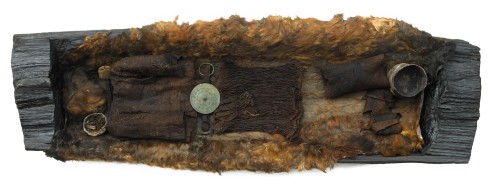New study confirms that Egtved girl and Skrydstrup woman were most likely from afar
A new study conducted by the University of Copenhagen and National Museum of Denmark confirms and corroborates the original interpretation of the iconic Nordic Bronze Age Egtved and Skrydstrup women’s provenances, which was most likely quite far away.

The Egtved girl. Photo: Robert Fortuna and Kira Ursem, National Museum of Denmark
Earlier this year, doubt was cast over the usefulness of some of the reference maps employed to decipher the geographical provenance of prehistoric humans. The critique was that the agricultural use of lime, in which strontium is present, severely contaminated the strontium isotope system in surface water used as a reference to shed light on the Egtved girl and Skrydstrup woman’s provenance. As such, doubt was raised over the assertion that the two women had come from far beyond present day Danish territory.
The criticism has now been refuted in a study led by geology and geochemistry professor Robert Frei and hydro-geochemistry associate professor Søren Jessen of the University of Copenhagen’s Department of Geosciences and Natural Resource Management, in collaboration with archaeometry professor Karin M. Frei of the National Museum of Denmark. Their study has now been published in the scientific journal, Science of the Total Environment.
"In the study, we established that strontium from agricultural lime does not significantly contaminate surface water systems. Therefore, the original interpretation of the Egtved girl and Skrydstrup woman grave finds stands," according to Professor Robert Frei.
Strontium isotope systems in water remain a valid geographic reference
Based on data collected through a representative soil profile of sandy heath plains in West Jutland, the authors of the new article demonstrate that strontium from agricultural lime products (used to increase soil alkalinity and enhance crop growth) is accumulated in and effectively contained by the top layer of soil. Consequently, strontium from agricultural liming does not penetrate into groundwater and is therefore not fed by groundwater into surface waters such as streams and springs.
The new study refutes Thomsen and Andreasen’s assertion that strontium from agricultural lime has a seriously contaminating effect on surface waters around the world, in areas dominated by ice-age drained sediments, and that consequently, strontium isotope values are useless as a reference for provenance studies of prehistoric humans and animals.
The results of the new study militate against such a generalization. The study presents data to support the validity of existing reference maps which are based on strontium isotope signatures of relevant bodies of surface water and serve as geographical references in the context of strontium uptake by prehistoric humans.
The new study highlights a range of important questions, the most important of which are:
- Has strontium from agricultural lime influenced surface water, as claimed by Thomsen and Andreasen? Answer: According to the new study, no. Strontium is effectively contained within the top layer of soil.
- Is the West Jutland heath plain truly lime free? Answer: The study demonstrates that natural carbonate fragments do occur. Strontium from these fragments dominate strontium in the groundwater.
- Are high strontium isotope values as measured by Thomsen and Andreasen in, for example, water holes, important within the context of prehistoric human provenance studies? Answer: According to the new study, no. Even though the water holes have high strontium isotope values, the strontium concentration is very low. This means that water intake from these holes plays an insignificant role for the strontium isotope signature in a human.
Facts
- A new article in the renowned scientific journal Science of the Total Environment responds to a critique raised by researchers Erik Thomsen and Rasmus Andreasen of Aarhus University’s Department of Geoscience (Thomsen and Andreasen, 2019) in their study published in the journal Science Advances. The critique questioned the use of surface water to characterize bioavailable strontium isotope signatures used as geographical references in archaeological provenance studies.
- The new study refutes Thomsen and Andreassen’s assertion that strontium from modern agricultural lime has a significant contaminating effect in surface water systems.
- The new study confirms and corroborates the original interpretation regarding the provenance of the two iconic Bronze Age women from Egtved and Skrydstrup, Denmark. Specifically, that they were from well beyond modern day Danish territory (excluding Bornholm).
Related News
Contact
Professor Robert Frei
Department of Geosciences and Natural Resource Management
University of Copenhagen
robertf@ign.ku.dk
Tel.: +45 35 32 24 50
Mobile: +45 30 62 31 36
Professor Karin M. Frei
National Museum of Denmark
karin.m.frei@natmus.dk
+45 41 20 61 81
Associate Professor Søren Jessen
Department of Geosciences and Natural Resource Management
University of Copenhagen
sj@ign.ku.dk
+45 51 37 06 93
Journalist
Michael Skov Jensen
The Faculty of Science
msj@science.ku.dk
+ 45 93 56 58 97
Communications Officer
Tina Bonde Christensen
National Museum of Denmark
Tine.bonde.christensen@natmus.dk
+45 41 20 61 44
